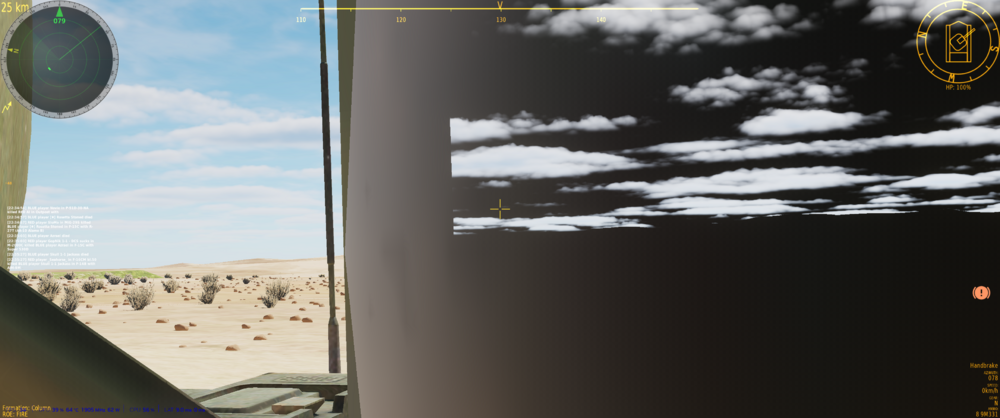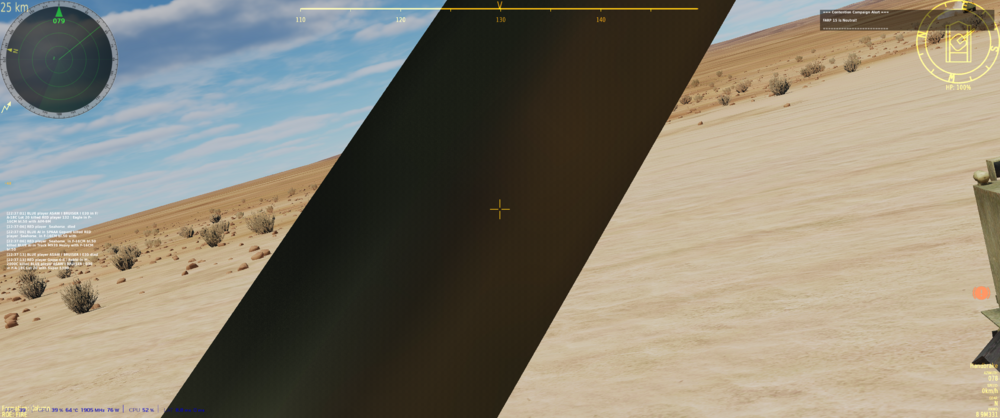-
Posts
2068 -
Joined
-
Last visited
Content Type
Profiles
Forums
Events
Everything posted by okopanja
-
I just spawned into TOR which appears to be source of the texture bug. I could move the head and see that the source is where I stand. I could see it from first person view, but not outside. null null Just got killed before I could make more screenshots. Please check the desert texture of Tor, there is already a bug report for that!
-
Just had the texture, was flying Ka-50 and it showed. My PC is freshly installed Win11 and freshly installed.
-
Will try. I am mostly on contention and a day or two ago, one person complained in the chat on Syria map.
-
Interesting... I can not replicate it anymore. Part of the problem is that I switched to Windows 11 and got everything reinstalled. Still have an old NVME with Win10, so I might boot it and check that as well.
-

Shark Planner: waypoint entry into Ka-50 ABRIS and PVI-800 from F10
okopanja replied to okopanja's topic in DCS Modding
I limited the choice of modules to the one I have. At the moment I have very little extra time, so I do not go into new modules. I will do some feasibility checks and estimate the effort based on Kiowa manual and what sort of way-points it supports. If you are familiar with lua, contributions are welcome. -
This dude drove both Trabant and Zastava: Also where the bicycles all baby-blue in DDR?
-

Germany Cold War Announcement | Steam Spring Sale 2025
okopanja replied to Graphics's topic in Official Newsletters
A air bases in Czech Republic/Poland planned at all? -

Urgent: Make the F10 card usable during the flight.
okopanja replied to Bernhard Strobel's topic in DCS Core Wish List
Most of the modules have at least one type of navigation means. Even in cold war most of them can use some sort of radio beacons. The most simple navigation aid kind is by using a compas and dead reckoning. E.g. you can set even the indicator on some of devices pointing at azimuth you need. E.g. Mi-8 has this and it is trivial tu use. F10 in main window is very unlikely to be implemented. -
So the missiles stopped tracking, despite holding lock all the time? Adding your tacviews... Tacview-20250312-194705-DCS-nerfed_r27.trk.zip.acmi Tacview-20250312-194217-DCS-nerfed_r27_mig29.trk.zip.acmi
-
Please explain but calmly, what is wrong and since when
-
All I can tell you is that it is related to: - Large servers (contention) - Normally I do use only 2 mods: Clickable FC3 (I can disable this, and based on the code it only activates for certain aircrafts) and my own mod (which is essentially an export script for entering nav points SharkPlanner ). I can disable both and let you know, but I am almost certain these are not the root cause. - it happens in places where CA unit was destroyed (might happen also with flying units) - its more likely to be reproduced with helicopter (I fly gazelle often, but I have seen it in Mi-8), but e.g. can happen even with low flying FC3 flanker. - Even though the texture looks like it stretches to infinity or is displayed a large flat explosion, as soon as you move the affected point from your FOV, the whole thing will disappear. Similarly, you move FOV back and its there again. I suspect that this is caused one of the objects which models the debris, which for some reason may have a broken geometry or incorrectly applied texture. It may be that the object is not removed from the scene for some reason. - Orientation is usually horizontal or vertical, but I have seen angled. When the thing started happeing back few months ago it was usually vertical and with finite 2D dimensions, but now it displays to infinity. - Also the texture is one sided, if you pass to the "other" side everything will look normal even if you look to the object that is causing this. - I think the only difference between crater and the monolith appearance is how the texture itself got applied (colors of both kind of match).
-
I saw it last week. If I remember correctly last updated was only about mission content, so the issue is still live and kicking.
-
https://tekcreations.slab.com/public/posts/dcsbios-installation-skunkworks-byjgzhpu
-
Its just my joke on practice to display new weapons in soviet times. Nothing really solid on release day.
-

Ka-50, Mi-8, Mi-24 removed from Russian ED store??
okopanja replied to flecktyphus's topic in DCS 2.9
If we are talking about licensing you can have least restrictive contracts where you as a company license and pay for fixed period. E.g. 1 year. When renewal is due, vendor may ask for more, e.g. by quoting inflation or other difficties which increase their costs. You can also license for multiple years with full upfront or periodic down payments (e.g. every year). Here vendor defines minimal duration after you can cancel. All has pros and cons. Lets hope this is just about money and not something more difficult. -
Actually ot looks like there is actually a bug here but in opposite direction. It appears that the missile can get close to 40-60m to the aircraft, explode and not kill the target.
-

Ka-50, Mi-8, Mi-24 removed from Russian ED store??
okopanja replied to flecktyphus's topic in DCS 2.9
It's nowhere stated, so lets wait and see... -
May 9th is the date.
-
Following the launch KUB missiles starts to track immediately after passing just few tens of meters. When targeting low flying targets on a flat ground this results in missile hitting the trees and other objects if not other units. Attached video and TRK file is created to demonstrate that missile starts correcting too soon (KUB placed on building for elevation purposes). TEST_KUB_guidance_activated_too_soon.trk
-
mode of operation is mostly low.
-
Yes that would be similar role, however the weaponry used is mostly of western and domestic origin. MAVs (A and B version) are used the same way as on Viggen. This airplane had a Warsaw pact twin in Romania called IAR-93 Vultur (one of the pics shows it). Very likely they had no access to western weapons. I think it was even added in WT. Romanian version got grounded somewhere in late 90s. I do not know much about their variant. Originally planned as single engine AB, it was instead fitted with 2 smaller Rolls Royce Viper engines. Initial batch did not have AB, which was later added. The forced 2 engine design reduced fuel efficiency and maximal speed of the aircraft to mostly sub-sonic (was supersonic in a dive). Airplane did see the combat, with practically all of the action remaining classified even today. The airplane provide close air support to troops in 1999. The only loss in air was airplane piloted by Života Đurić. Details remain classified, but he appears to have been part of low flying 2-ship, and got hit from the ground on second turn, once he dropped cluster bombs. Location remains unknown. It should be noted that these aircraft together with G-4 clocked more air time than 29s in this war. Starbaby mentions detecting low flying sub-sonic airplane, him believing to be Mig-21, but I believe he detected either J-22 or smaller G-4 Super Galeb, since not a single Mig-21 took of during the war, except for airplanes evacuated after the hostilities ended from Slatina airbase underground shelter. As for the pictures: we see mixed pictures of original version and contemporary upgrade (mfd, flir, etc). While the documents were leaked for the original it is unknown what is the confidentiality status. The remaining airplanes will likely be used for another decade at least. For upgraded version, I do not think we will see that. The aircraft itself would be very interesting in 80s setup in its original form with no MFDs.
-

How big is the biggest possible DCS installation with all maps/modules?
okopanja replied to warmachine79's topic in DCS 2.9
There is a number of half-baked maps and modules, it will be interesting to see this 2 years later. -
So how heavy is the SA-2 warhead?
-
I did not see it yet on BlueFlag. It has no dynamic slots BTW: I have seen both of these happening (crater and "monolith") on contention, both artifacts both on Caucasus and Syria. More likely to happen on Syria, and "monolith" is probably related to the exploded unit as well.
-
@TotenDeadin the table is missing Dragan Ilić who was on direct intercept course at distance of 60km when he got hit. He managed to land aircraft at Nis airbase, but to this date it is not known what hit him, enemy or our own air defense. His aircraft was destroyed with bombs few days later.





